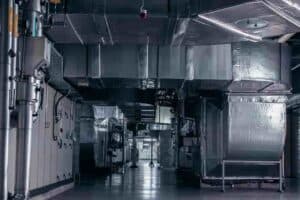Since the pandemic, there is greater pressure and responsibility for commercial landlords to review the air quality in their properties. Occupants have increased concerns about the air they’re breathing and the risk of airborne transmission of coronavirus.
Here we outline how building owners and commercial landlords can exceed air quality standards without undergoing expensive renovations.
Commercial landlord responsibilities for HVAC
The responsibility for the operation, maintenance and cleaning of a building’s heating, ventilation and air conditioning systems will be agreed between the building owners and commercial landlords. This is so they can ensure a safe and healthy environment for its occupants.
A well-maintained system reduces the risk of inhabitants’ exposure to unclean air.
HVAC system inspections
The responsibilities will include regular inspections of the building ventilation system in their properties and buildings in line with TR19. This is to ensure the systems are working efficiently and to the highest standards. It also enables commercial building owners to identify ways they can reduce their operating costs and bring down the level of harmful carbon emissions. This could either be through improvements to the existing system or replacing it with a newer, more energy-efficient system.
HVAC maintenance checks
Building owners should have regular maintenance checks of their properties’ HVAC system in accordance with TR19. This way, you can be assured it continues to work at peak performance.
You may think your HVAC system is working fine, but without undertaking regular maintenance checks, you won’t be able to tell if it’s working effectively and doing its job of maintaining the indoor air quality.
You should also consider planned preventative maintenance. Unplanned maintenance can be costly, so with regular maintenance, you can reduce the potential for unexpected costs and breakdowns.
UK indoor air quality guidance for commercial properties
There are several pollutants that can affect indoor air quality. One pollutant is particulate matter. This is typically produced from common activities such as cooking, cleaning, dust and fixtures and fittings. Common products such as cleaning products, aerosols, candles and glues can also emit what’s known as volatile organic compounds. Lastly, a poor heating and ventilation system can result in mould or excess humidity in a building, which can cause a serious health hazard.
Current guidelines specify the importance of indoor environments and limiting the levels of particulate matter or volatile organic compounds.
Government Covid-19 guidance recommends that windows and doors are kept open where possible to increase the flow of air and circulate fresh air from the outdoors into the building.
However, the concern around this is the potential for allowing outdoor pollutants indoors – this is particularly an issue around busy road networks due to particulate matter pollution and NOx. Natural ventilation is not as effective as mechanical ventilation and filtration. However, poor air filtration can also result in contaminated air with people at greater risk of illnesses such as lung conditions, heart disease and inflammatory conditions.
There is also the focus on energy efficiency restrictions which can reduce the ventilation rates of a property.
Commercial landlords’ responsibilities for improving air quality
There are landlord guidelines to help building owners improve the level of ventilation in their properties.
With air carried from room to room throughout a building, it increases the risk of airborne transmission of viruses.
A well-maintained ventilation system will be effective in improving overall indoor air quality. Good building service installations are best seen and not heard. If not maintained properly, fans going off balance may result in squeaks, contributing to an increase in noise levels. However, you can reduce the risk of a sudden system breakdown through regular and planned preventative maintenance.
How commercial landlords and building owners can improve air quality in commercial properties
Commercial landlords should explore the option of air quality monitoring, auditing and filtering. However, the quality of indoor air will change continuously, and so continuous monitoring is key.
UVGI solutions
Landlords can reduce risks and improve air quality through UVC technology. UVC technology helps kill the airborne transmission of viruses in recirculated air.
The Plasma Clean TechniKlean solution improves indoor air quality by ensuring ductwork stays clear and air is disinfected through air handling units with a 99+% microbial kill rate.
A solution that kills microbial growth and helps maintain optimum heat transfer across the coil surface is CoilKlean UVGI.
Want to find out more about how we can support you with cost effective methods for improving air quality in your commercial properties? Reach out to us at [email protected].








